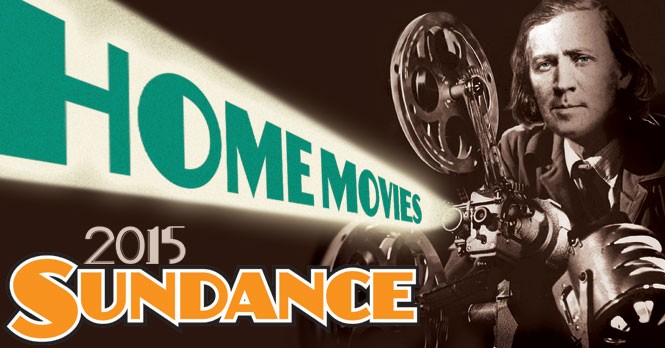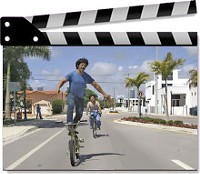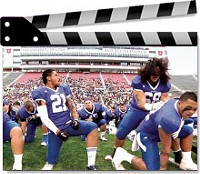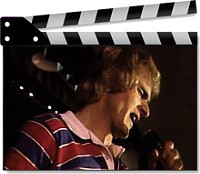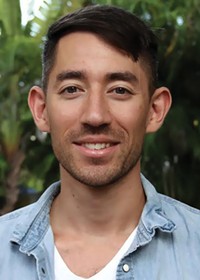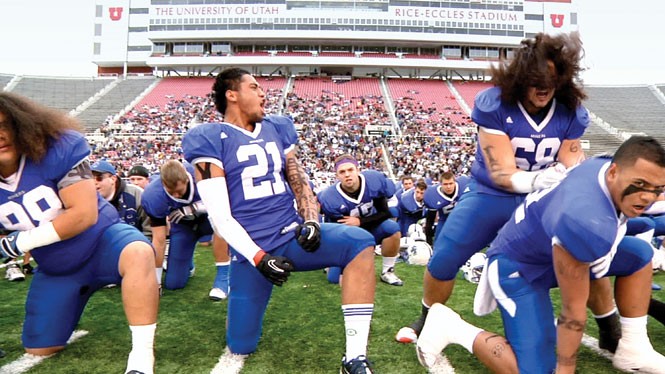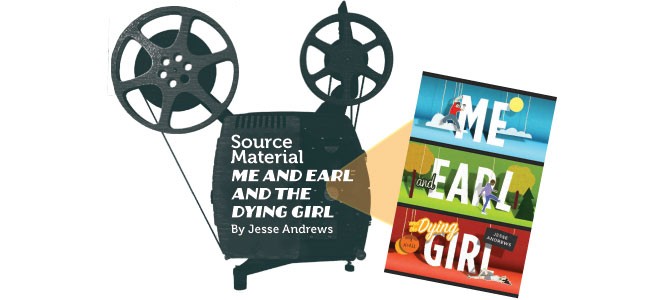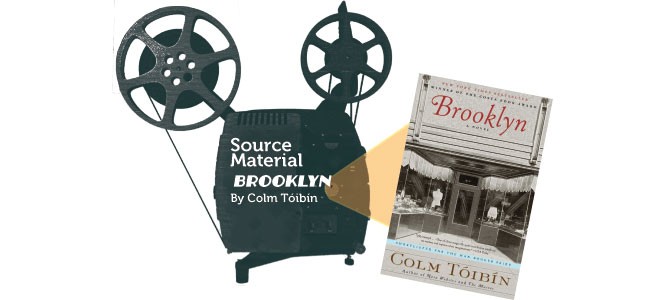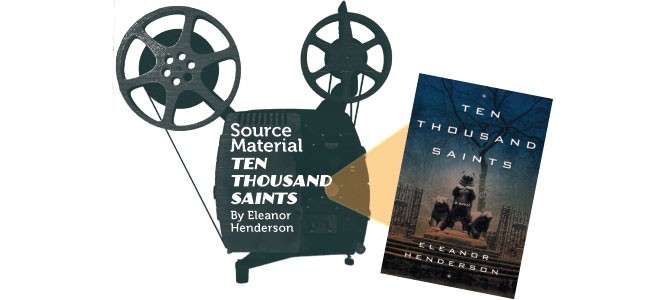Sundance Film Festival 2015
The films, the personalities, the inspirations, the books and even the apps of this year's festival
By Danny Bowes and Scott Renshaw @scottrenshawThe Sundance Film Festival draws filmmakers from all over the world. But this year, it’s also a showcase for directors with Utah roots. Meet four young filmmakers who made it into the lineup of their hometown festival
Learn a bit more about the source material for some of this year’s films.
How to use the Sundance app to simplify your festival experience.
The Strongest Man
Utah native Kenny Riches tells a Miami story with a little help from his friends.
By Scott Renshaw
For many young filmmakers, it all begins with hanging out with your pals and shooting the fun that you have together. That's certainly the case for writer/director Kenny Riches, except not all that much has changed in 15 years—unless you count having the chance for the whole world to see your work at a major film festival.
Riches, a Salt Lake City native, will be bringing his feature film The Strongest Man to the 2015 Sundance Film Festival. It tells the story of Beef (Robert Lorie), a Cuban-American living in Miami and working in construction, where his impressive physical size is helpful in a way that it isn't in terms of helping him cope with his many anxieties and insecurities. Also part of the story are Beef's best friend, Conan (Paul Chamberlain), a Korean-American living in the shadow of his more successful brother, and Illi (Ashly Burch), a girl who has just moved back from college, and whom Beef has had a crush on from afar for many years.
Lorie, Chamberlain and Burch—along with co-star Patrick Fugit, a fellow Salt Lake native best known for Almost Famous—are all part of a close-knit group of creative friends with whom Riches regularly works, including his producer Jesse Brown and editor T.J. Nelson. According to Riches, "It's definitely the way I prefer to work. ... For my comfort level, it's good to work with people I know. And, he adds with a laugh, "half the reason I make films is so I can force Pat [Fugit] into being in them."
It's a dynamic that goes back to the mid-'90s, when Riches was a teenager in Salt Lake City. Through the local skateboard scene, he met Fugit, and through him later met Nelson, Brown and also David Fetzer, a local writer/actor whose life and death in 2012 were chronicled in a December 2013 City Weekly feature. "T.J. used to shoot skate videos doing VCR-to-VCR editing," Riches says. "Then the skateboard videos turned into making videos of your friends doing stupid stuff."
Yet Riches didn't initially envision himself as a filmmaker. He studied painting and drawing with the goal of focusing on visual arts, and even opened Salt Lake City's Kayo Gallery. It was really only through Fetzer and Fugit, he says, after he returned to Utah from a year of studying art in Denver, that he began exploring vintage films—he cites French New Wave and '70s American cinema in particular—and considering the prospect of making movies himself.
"[Fetzer and I] decided to become roommates," Riches says, "and it wasn't until that point when I really became immersed in [film]. Because, it was kind of like he was my teacher, he and Patrick. When you hang out with people who care so much about character and performance and writing and the art of filmmaking ... it was really at that point where everything changed."
Riches collaborated with Fetzer and Ashly Burch on his first feature, the 2012 romantic-comedy-drama Must Come Down. They submitted it to Sundance—because, as Riches puts it, "it's what you're supposed to do"—but it was not accepted. Riches acknowledges now that the film wasn't in line with the kind of writing he had been doing previously.
"I was very worried about having [Must Come Down] be marketable," Riches says, "so it's much safer, kind of cuter. For [The Strongest Man], it was like, 'I just want to make this film no matter what, I don't care.' "
The result is a quirky, sometimes surreal movie—full of strange creatures with glowing eyes, and a Pee-wee's Big Adventure-esque quest for a stolen bicycle—shot in Riches' new home of Miami, where he and his girlfriend (and art director), Cara Despain, moved 2 1/2 years ago. But while it's certainly a Miami story in its use of the city's geography and its particular cultural melting pot, it's still the kind of project Riches seems to gravitate to most: one built around his friendships.
"The movie is a lot more funny than I anticipated," Riches says. "Paul [Chamberlain, who plays Conan] is so funny in real life, but I didn't know how much of that he would bring to the film. ... He took that character, and it's much more funny than it was on paper. But I love that aspect of it: You expect one thing as you're writing, but once you get on set, things just happen, and you fall in love with the things that are happening."
Now that The Strongest Man is part of the Sundance lineup—a success Riches says Despain and Brown "just knew" would happen—Riches says there's a benefit that comes from being part of a festival where he grew up in its backyard. "This is my turf," he says with a smile. "Everyone I know gets to see—or try to see—the movie."
Riches is also back in a place where he still has many emotional links. As vice-president of the David Ross Fetzer Foundation, he's involved in helping support locally the kind of artistic projects he believes his late friend would have loved; a title card for The Strongest Man carries a production logo that is a nod to Fetzer. And as Riches moves forward with his filmmaking career—whatever direction it takes after Sundance—the connections to his friends still inform the way he tries to create.
"[Fetzer and I] would watch movies then write our own short films, and it was all building up to do bigger things," Riches says. "Everything I write now, I imagine David reading it and how he would react. ... If he would say it sucks, I've got to cut it."
In Football We Trust
Tony Vainuku and Erika Cohn bring a little-seen culture to the screen.
By Scott Renshaw
Tony Vainuku realizes that he may be about to introduce film audiences to a culture they don't know much about: "There's no reality TV show about Polynesians," he says with a laugh.
In Football We Trust—co-directed by Salt Lake City natives Vainuku and Erika Cohn—explores Polynesian-American culture through the game that has created the culture's most prominent public figures in NFL, stars like Junior Seau and Troy Polamalu. But it's also an intimate study of three Utah families, as Vainuku and Cohn spent five years following four high school students trying to make their dreams of pro-football stardom a reality: Highland's Fihi Kaufusi, Bingham's Harvey Langi and Hunter's Vita and Leva Bloomfield.
The project didn't begin, however, with a goal of focusing on kids. Seven years ago, Vainuku had an idea about a documentary that would be primarily about Polynesian-Americans in the NFL, from pioneers like Vai Sikahema (now retired) to contemporary players like Utah native Haloti Ngata. But eventually, that concept evolved into one inspired by Vainuku's uncle, Joe Katoa—a promising football prospect who, according to Vainuku, "had all the potential in the world to go to the NFL, but ended up going to prison."
"But," Vainuku says, "his story had already happened. So it was like, 'How do we tell that story?' Through kids in high school who were going through the same things that he went through in his life."
Vainuku received initial guidance and mentorship from Utah's own Jared Hess (Napoleon Dynamite) before meeting award-winning producer Geralyn Dreyfous (Born Into Brothels), who introduced him to Cohn in 2010. Where Vainuku was inexperienced as a filmmaker, Cohn had been a student and eventually a teacher at SpyHop, then served as an intern with the Sundance Institute.
The filmmakers then set out to find their film's subjects, though Vainuku already had Harvey Langi in mind as a result of the athlete's prominence as a star college recruit at the time, and the Bloomfields because of their connection through their father to the Polynesian gang culture that often challenges the community. And Vainuku and Cohn found that the families were willing to trust them with their stories. "They were really supportive," Vainuku says, "because I was Tongan. ... They knew that I had their best interests at heart and that I could tell that story."
Finding willing subjects turned out to be the easy part. It was considerably harder dealing with the economic challenges of trying to make a documentary film on limited funds, and the project that they ambitiously thought might take only two years to complete instead stretched into five years. But that also allowed the filmmakers to capture a wide variety of challenges facing their subjects, from run-ins with the law to injuries, from being called the "salvation" of their poor families to a challenging freshman college season.
The result is something with echoes of the great 1994 documentary Hoop Dreams—about the pro-sports ambitions of two Chicago-area African-American high school students—and even employed one of that film's editors, William Haugse, in addition to getting encouraging feedback from Hoop Dreams director Steve James.
"If people associate [In Football We Trust] with [Hoop Dreams]," Cohn says, "that's a wonderful compliment."
"But I think that backs up ... how we knew this story was universal," Vainuku adds. "Everybody's going through [the experience of] trying to create opportunity in America."
Vainuku and Cohn come at the experience of being in the Sundance Film Festival lineup from very different histories. For Cohn, who recalls that, as a festival intern 10 years ago, she "schlepped all the producers around, got them coffee ... got groceries," it's familiar territory. "[Erika's] one of those rare breeds who knew what she wanted to do at 14," Vainuku says with a smile. "She was always destined to be in Sundance."
For Vainuku—the first director of Tongan-American descent in the festival's history—Sundance seemed like a different world. "I feel like I snuck in the back door, and now I just want to get a few drinks while I'm at the party," he says with a laugh.
But while the filmmakers will enjoy sharing their sold-out premiere at The Grand Theatre with the film's local subjects and their own families, the real goal is to continue advancing In Football We Trust's goal of educating youth, particularly those of Polynesian descent, about the pitfalls and opportunities they might face. Vainuku hopes to use the Sundance Film Festival platform to get that message out, and for fundraisers like the celebrity Strikes for Scholarships event—featuring NFL players like Ngata—on Jan. 25 at Park City's Jupiter Bowl. "It's said some films die at festivals," Vainuku says. "We want it just to be the beginning.
It's also a chance for Vainuku himself—who's also an entrepreneur, and launched his Soulpro clothing line during one of the hiatuses in production of In Football We Trust—to be an example of what other paths are available to Polynesians beyond professional sports. "Our tag line is 'Make your own history,' " Cohn says. "Don't put all your eggs in one basket; there's more to life than football. Tony is kind of embodying that through being the person behind the camera."
Beaver Trilogy Part IV
Brad Besser takes a journey through Trent Harris' made-in-Utah cult classic.
By Scott Renshaw
If you're a young aspiring documentary filmmaker, you could probably find a more encouraging subject to profile than a filmmaker whose work almost nobody has ever seen.
But Sandy native Brad Besser found a uniquely inspiring subject in Utah's own Trent Harris. And he had a fascinating launching pad for a documentary in Harris' cult classic Beaver Trilogy.
Beaver Trilogy Part IV finds Besser on a dual journey, with Harris' short-film triptych at its center. Part of the story follows Besser investigating the questions he was left with by the documentary portion of Beaver Trilogy, which chronicles Harris' chance meeting in 1979 with a young man identified only as Groovin' Gary, and subsequent visit to the man's hometown of Beaver to watch him compete in a talent contest singing in drag as "Olivia Newton Dawn." Yet it also becomes a profile of Harris himself, a filmmaker who once seemed poised to hit the big time but has instead remained an under-the-radar maker of highly personal experimental movies.
Besser traces his fascination with Harris back to junior high school, when a friend had a copy of Harris' 1991 film Rubin & Ed, an oddball comedy about two men on a desert quest to find the perfect spot to bury a dead cat. "We were always quoting it," Besser says: " 'My cat can eat a whole watermelon.' I always thought Trent was kind of a mythical figure, then I found out he was from Utah. Actually finding out there was another guy that had done it, and was from here, was kind of inspiring."
Later, Besser took a class on screenwriting at the Utah Film & Video Center where Harris was the instructor. It was there that Besser first encountered the three short films that would eventually come to be known collectively as the Beaver Trilogy: Harris' initial documentary about Groovin' Gary, and two subsequent dramatizations, one a grainy black & white version starring a pre-Fast Times at Ridgemont High Sean Penn; and Harris' AFI thesis film The Orkly Kid, with Harris' later Rubin & Ed star Crispin Glover.
Besser originally set out to make a film just focused on the unanswered questions of Beaver Trilogy: Who was Groovin' Gary, and what became of him after Harris captured him at that talent show? And he does find some answers, ultimately tracking down friends and family members of the man whose real name he learned was Dick Griffiths. "There was a great story," Besser says. "A lot of people had talked about the Beaver Trilogy, but not from the Beaver Kid's side."
At the same time, Besser came to realize that there was also a more expansive story to be told about Harris' life and career as a struggling independent filmmaker. "Our initial interview with Trent," Besser says, "he was very aggressively against talking about the Beaver Trilogy. He wanted to talk about everything else that wasn't Beaver Trilogy. And he had these kind of loaded sentences: 'People ask all these questions, and they never really get it.' I took it that he meant people didn't get him, get his process."
Besser wound up following Harris through the long process of making his latest feature, Luna Mesa, including a disappointing London premiere event. He catches Harris fretting over the minuscule amount of money in his bank account, and ruefully joking that Besser's movie is "probably even a worse idea than I've come up with."
Along the way, Beaver Trilogy Part IV comes to explore a connection between Harris' struggles to make a career as a filmmaker and the story of The Beaver Kid. "Throughout Trent's interviews," Besser says, "he was talking a lot about reality—what's real, what isn't real. Then when we went down to Beaver, they also talked a lot about reality, and Hollywood—how Dick, when he was younger, had trouble figuring out the difference between TV and what can be your real life, and somehow the dream isn't what it's cracked up to be."
Besser himself has achieved something that might be considered a dream for a documentary filmmaker by getting into the Sundance Film Festival—a bit of a different perspective than he had in recent years, when he was a festival volunteer at the Eccles Center. "I do feel pretty comfortable, in that I've seen the behind-the-scenes," Besser says. "But it also makes it that much of a bigger moment. When you're a volunteer at Eccles, escorting the director to the stage, you can feel the 'I wish I was there.' ... The last two years, it couldn't help but motivate me to get through those tough days, those long days."
He also has a different perspective, he believes—simply by virtue of what he learned from making Beaver Trilogy Part IV—about the challenges of trying to make a life as an artist. "When you're a kid," he says, "you don't pay attention to studios or box office; you just pay attention to your VHS collection. I just loved Rubin & Ed, and it was there on the shelf with all these other movies. It just seemed like they were all great movies.
"There was a certain kind of innocence getting back to that: Maybe we shouldn't get wrapped up in box office, and just love the movies we love."
Sundance By the Book
By Scott Renshaw
The Sundance Film Festival may be best known as a showcase for original work by new filmmakers, but that doesn't mean some of the films aren't drawn from pre-existing source material. Here's a preview of a few Sundance 2015 titles by way of the books that inspired them, just to give you a flavor of what you might expect.
Book Overview: Greg, a deliberately anonymous high school student, finds his senior year disrupted when he befriends a girl who has been diagnosed with leukemia. Andrews tells the young-adult story in Greg's engagingly self-deprecating first-person voice, though his brutally low self-esteem gets laid on a bit thick at times. But despite the subject matter, the story is never awash in pathos, instead finding insightful material in a kid engaging with real difficulty on the way to learning he's got more to look forward to than he ever realized.
Book Grade: B+
Reason for Adaptation Optimism: Andrews adapting his own book for the screenplay, which might help it keep some of its darker edge.
Reason for Adaptation Concern: Will there be too much of an attempt to preserve Greg's voice through narration, which often kills narrative momentum?
The Movie Pitch: "The Fault in Our Stars meets Ferris Bueller's Day Off"
Sundance Category: U.S. Dramatic Competition
Book Overview: In early 1950s Ireland, young Eilis Lacey takes advantage of an opportunity to move to New York for work, then finds herself struggling to decide where she belongs in the world. Tóibín's deceptively simple style allows Eilis to develop a beautiful complexity as a woman with ambitions for herself, at a time when neither of the paths from which she's choosing would ultimately allow her to achieve those ambitions. As a result, it's perhaps the most heartbreaking kind of romantic triangle imaginable—one where a reader's most fervent wish might be that Eilis had the option to select "none of the above."
Book Grade: A-
Reason for Adaptation Optimism: Hard to imagine a more perfect choice as Eilis than Saoirse Ronan.
Reason for Adaptation Concern: Director John Crowley has talent, but recent films like Is Anyone There? and Closed Circuit haven't shown a subtlety necessary for this story.
The Movie Pitch: "The Immigrant meets In America"
Sundance Category: Premieres
Book Overview: After the death of his best friend, Teddy, from a drug overdose, troubled teen Jude moves to New York in 1988 and forms a makeshift family including the girl carrying Teddy's baby, and Teddy's straight-edge half-brother. First-time novelist Henderson crafts some absolutely gorgeous prose as she dives into the world of young people united by their sense of devotion to a ghost, and she nails a very specific era in New York City leading up to the Tompkins Square Park riot. The vivid characterizations contribute to a fascinating portrait of kids trying to navigate the path to adulthood despite getting negligible amounts of parenting.
Book Grade: A-
Reason for Adaptation Optimism: Writer/directors Robert Pulcini and Shari Springer Berman previously did great work adapting challenging source material like American Splendor; a solid cast including Hailee Steinfeld, Ethan Hawke and Emily Mortimer.
Reason for Adaptation Concern: Feels more like a work that succeeded because of the author's voice than because of a narrative easily translated to the screen.
The Movie Pitch: "Rent meets Kids"
Sundance Category: Premieres
Book Overview: After a nuclear war, a teenage girl in an upstate New York valley believes she may be the last surviving person—until a scientist appears after almost a year has passed with no other humans in sight. Presented in the form of the girl's diary, the book is focused almost entirely on plot momentum, in a style that has the straightforward sensibility of a '70s middle-grade story yet also features attempted rape and abrupt, violent tone shifts. Intriguing until it gets far too grim as a psycho-chases-a-girl thriller.
Book Grade: C
Reason for Adaptation Optimism: Terrific cast trio of Margot Robbie, Chris Pine and Chiwetel Ejiofor; directed by Craig Zobel, who nailed the darkly psychological Compliance a couple of years ago.
Reason for Adaptation Concern: It's clear from the Sundance logline that the concept has been radically changed into something more like a romantic triangle. Come to think of it, maybe that's another reason for optimism.
The Movie Pitch: "The Road meets Straw Dogs"
Sundance Category: U.S. Dramatic Competition
Put Sundance on
Your Smartphone
Being a movie buff and a new enough Utah resident that every time someone mentions Park City, I think, "Park Chan-wook has a city named after him?", I welcome the idea of an app that simplifies the Sundance Film Festival experience.
The Android version of the Sundance 2015 app, to which all references hereafter apply—the iPhone version, one presumes, is pretty much the same—is a stylish, functional-looking thing. It offers, in one tab, the option to "Discover" titles, which are presented with their title and a film still. The full schedule of public screenings is sorted not only by date, but by town (Ogden, Park City, Provo and Salt Lake City) and desired festival subsection (Competition, Documentaries, World, etc.). There is the standard ticket-ordering tab, as well as an "eWaitlist" option for the system launched in 2014 to get on the waitlist for sold-out events electronically (the "eWaitlist" for 2015 was not yet active at press time). There are maps of all four venue cities with festival locations, a list of venues by category and a "favoriting" feature for bookmarking any of the items mentioned above (except the Park Chan-wook joke, but that goes without saying).
In terms of functionality, the app runs smoothly, with clearly marked options at every stage. It slows down a bit when working through the schedule and maps sections, even freezing while trying to access maps. But closing it and reopening solves that issue fairly conclusively, and thus, it's what it sets out to be: a useful tool. It could probably stand an update or two to the schedule and maps sections to sort out the sludginess, but that's all that's standing between the app as it exists now and a perfect realization of what it could be. It comes highly recommended to smartphone-using festival-goers, both experienced and inexperienced.
More by Scott Renshaw
-
Film Reviews: New Releases for April 19
The Ministry of Ungentlemanly Warfare, Abigail, The Beast, Hard Miles, Sasquatch Sunset and more
- Apr 19, 2024
-
Faces of Salt Lake County book and portrait reception
Images and personal stories in a new book reveal local demographic diversity
- Apr 17, 2024
-
Feature film review: THE BEAST
A filmmaker's compelling ideas get a bit tangled in references to his creative influences.
- Apr 17, 2024
- More »
More by Danny Bowes
-
Live: Music Picks Jan. 28-Feb.3
Grizfolk, Dawes, Salt Lake City Songwriters Showcase and more
- Jan 27, 2016
-
Pilot Program, 5 Lesbians Eating a Quiche, Mr. Perfect
Three new theater productions address unique romantic complications
- Apr 15, 2015
-
Furious Debate
Two critics go head-to-head over their differing perspectives on the Fast & Furious series
- Apr 1, 2015
- More »


